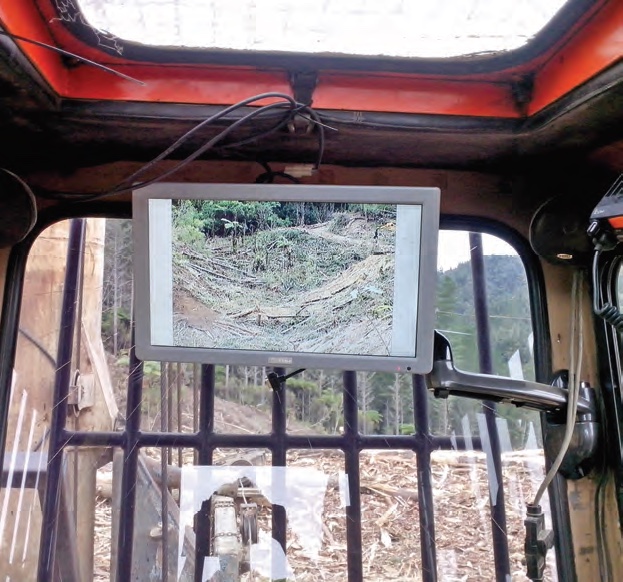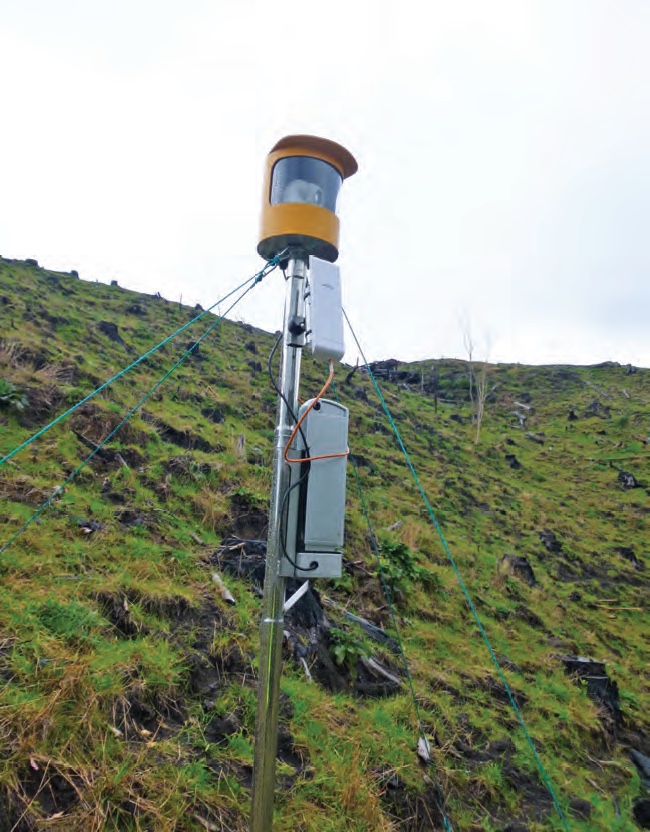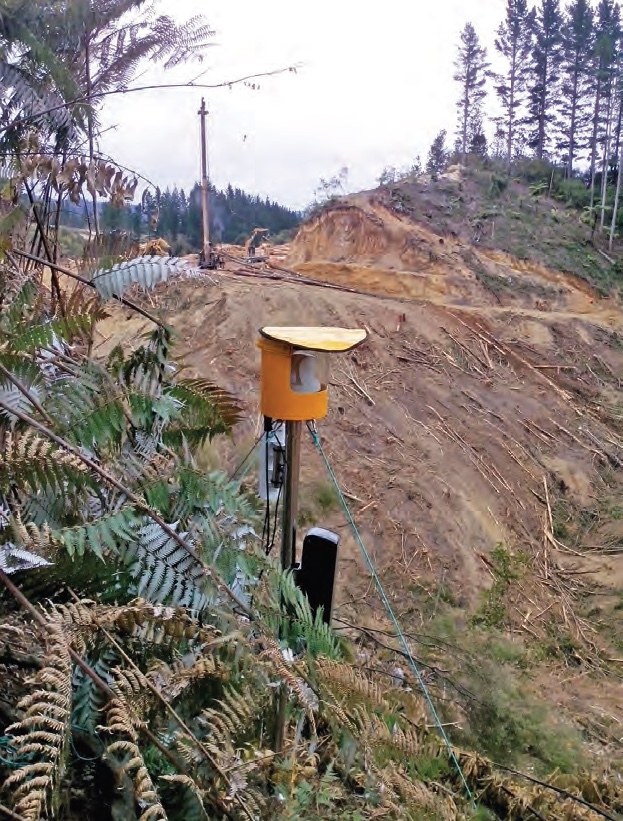The CutoverCam hauler
Paul Milliken, New Zealand Tree Grower November 2014.
The CutoverCam is a new hauler system which provides improved vision of the working area for the hauler operator. It helps to improve safety and increase productivity by giving the hauler operator a clear view of the work area.
The CutoverCam was designed, developed and tested by Future Forest Research as part of their harvesting research programme. The aim was to help improve safety and productivity in steep harvesting operations. It has been tested in tower-haulers, swing-yarders and harvestline machines. Trials were also carried out in choker and grapple operations.
Initial tests used a fixed camera on a tripod which was situated in the cutover and sent video to the hauler over a wireless link where it was displayed on a screen. The system was found to be useful, but operator feedback suggested that it needed −
- Remote-controlled pan, tilt and zoom
- A stand that could tolerate high winds
- High quality optical zoom
- A large bright screen in the cab.
These were added and resulted in the commercially available system.
The camera and cab equipment
The CutoverCam consists of two parts. The first part is a portable camera assembly which can fit in a backpack and a waterproof case. The camera can be set up in a location with a good view of the logging operation. The camera assembly can be erected in around six minutes and the battery will last for a week of operation, if the camera is switched off each night. It can operate in the rain and includes a canvas hat to protect the camera’s windscreen from raindrops or sun glare.

The second part of the system consists of a screen, electrical box, wireless receiver and joystick. These are installed in the cab of the hauler. The installation in the cab runs off the hauler’s 24-volt supply.
The hauler operator can control the angle of the camera over a 180 degree range via the joystick. Tilt can be controlled over a 60 degree range and the optical zoom can be up to 18 times magnification. This means that once the camera is set up, the hauler operator can remotely control it to view any part of the operation within line-of-sight of the camera.
The operator can use buttons on the joystick to adjust the exposure for a back-lit setting and to mirror the image. Mirroring gives a more realistic view for the hauler operator if the camera is pointing back towards the operator. In low-light conditions the camera automatically switches to night-vision mode, which allows it to operate around dawn or dusk. An additional safety feature is that if the wireless link is disrupted, a warning is displayed on the monitor, indicating that the video stream is not live.
The benefits

There are three main benefits of this system when using breaker-outs. First, the hauler operator can see the location of the breaker-outs, the workers on the hill, before moving the ropes. Because the hauler operator has a good view of the workers, they no longer need to rely on radio messages and sound signals alone, which adds another layer of safety.
The hauler operator gets instant video feedback if there is a problem when the tree stems are in motion. For example, if a stem digs-in and swings towards a worker, the hauler operator can respond immediately, avoiding a possible accident. Third, a good view helps to avoid the tree stems hanging up or digging into the ground. This means less log breakage and less wear and tear on the ropes and the hauler.
When using a grapple with a good view via the screen in the cab the benefits include −
- The spotter free to do other work when the camera has been set up
- Greater productivity than when relying on voice instructions from a spotter
- Fewer broken tree stems and reduced wear and tear on equipment.
The cost
The cost is under $20,000, not including installation, but free demonstrations can be organised on request. It would normally be bought by logging contractors, sometimes by forestry companies who supply the system to their contractors. As noted, its main aim is to allow the hauler operator to see the workers so they are not operating on verbal or tooter commands and so makes breaking-out much safer.
The CutoverCam can mean increased cycle times and improved productivity. The price puts it within the range of small-scale foresters. It is beneficial to have one of the systems when harvesting because the better vision gained by the hauler operator. It helps to avoid hang-ups and dig-ins, resulting in cost savings from less wear and tear on the hauler and ropes.
Other benefits for small-scale foresters
The Approved Code of Practice for Safety and Health in Forest Operations says that all cable harvesting operations have to use an effective and established communication system. Traditionally this has been by a combination of toots on a hooter and verbal communication over a radio link. However, in harvesting operations adjacent to urban areas, operating a tooter early in the morning may be a problem. In this situation the combination of a CutoverCam and radio communication provides an alternative. It can also be customised for other situations which need a remotely operated camera system. For example, cameras can be added to remote-controlled machinery such as remotely-controlled winches so the operator can have a view of the winch drums.
Other options

There are other ways to ensure good safety and productivity. A fixed camera can be used which transmits a view of the break-out area via a wireless connection. This provides a cheaper option, but operator feedback during its development indicated that the convenience of the remote-controlled pan, tilt and optical zoom was an advantage.
Another device that can be used to check the locations of breaker-outs working among the trees is a personnel-mounted GPS receiver. This transmits the GPS location to the hauler over a wireless connection. The main advantage is that there is no need to set up a camera.
However, the CutoverCam has two main advantages over GPS-location systems. First, a live video stream provides the hauler operator with a detailed view which contains more information than just the location of a person. Second, when the CutoverCam is operating, people are not in close proximity to the wireless transmitter, reducing exposure to electro- magnetic radiation.
When using grapple carriage such as the Falcon Forestry Claw or the Alpine grapple-carriage, a camera can be installed in the underside the carriage to provide a view directly below the grapple. These systems usually use rugged Agcam cameras. The cameras are commonly installed on grapple carriages and they have two advantages over the CutoverCam for grapple operations.
First, when picking up a stem with a grapple a view from above is ideal when grabbing a stem. Second, the camera stays installed in the grapple carriage so there is no set-up time. However the CutoverCam provides a broader spotter’s view of the cutover and does not suffer from motion blur when the carriage is moving or swinging. Agcam cameras can also be mounted on mechanical grapples providing that the camera and wireless transmitter are very well protected.
Paul Milliken is Director of Cutover Systems Limited based in Rotorua and the CutoverCam system is available from this company.

 Farm Forestry New Zealand
Farm Forestry New Zealand

